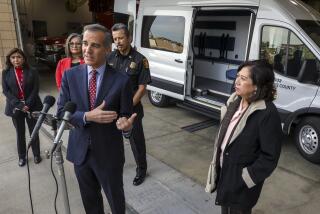LAFD chief to shift firefighters from trucks to ambulances
Los Angeles Fire Chief Brian Cummings said Thursday he was pressing ahead with a controversial plan to move dozens of city firefighters from fire engines to ambulances, despite warnings from labor groups that the change would put lives at risk.
In the coming days, the chief plans to deploy 11 new ambulances by reassigning one firefighter per shift from 22 firetrucks across the city. Cummings says the department must adjust to fewer fires and a growing number of medical emergencies, and has limited funding to make the change.
“After asking for money and not receiving it, I am moving forward,” he said.
Both candidates for mayor have expressed concern about the change.
City Controller Wendy Greuel, who has been endorsed by groups representing city firefighters and most commanders, said the new plan “continues to put our first responders and our communities at risk.”
A spokesman for her rival, Eric Garcetti, said the councilman does not believe the changes should be implemented until the department can prove they make sense. “He wants to see the real data,” spokesman Jeffrey Millman said.
Medical calls now account for more than 80% of 911 responses, and the chief says that figure is growing rapidly. In the first two months of this year, medical calls increased 6.2%, compared with the same period last year, Cummings recently reported.
Labor leaders said Thursday that the chief’s plan was hastily drafted and thinly researched. They called on Mayor Antonio Villaraigosa and the City Council to provide more money to staff ambulances, rather than take firefighters from engines.
The firefighters’ union president, Capt. Frank Lima, urged residents to complain to elected officials about cuts to the force in recent years. “It’s time to speak up, it’s time to get angry,” he said.
He spoke at a news conference outside of the charred remains of a North Hollywood apartment where one person died and four others were injured earlier this week.
Two fewer firefighters would have responded to the blaze under Cummings plan, he said. “Without a doubt, there would have been more fatalities,” he said.
Earlier in the day, labor officials tried unsuccessfully to persuade the Fire Commission to postpone the changes. Assistant Chief Andy Fox, president the Chief Officers’ Assn., complained that Cummings had failed to show that firefighter safety would be protected.
“If you remove one firefighter, it’s like asking the Dodgers to play without a center fielder,” Fox said. “Yes, they can play the game. Over time, it would prove to be a very bad idea.”
About 60 firefighters assigned to so-called light forces, teams made up of a ladder truck and fire engine, will be reassigned under the plan. Currently, each light force is staffed by six firefighters who perform specialized roles during fires and rescues, including car accidents.
The chief’s redeployment would leave many light forces with five firefighters, but allow for the new ambulances, LAFD officials said. The ambulances would be staffed by firefighters trained to handle less serious medical emergencies not requiring a firetruck or more highly trained paramedics.
The department’s fleet of non-paramedic ambulances will increase by about one-third, to 45, officials said. That will help free up about 90 paramedic units to respond to the most life-threatening calls, they said.
The shift also aims to reduce responses by heavy firetrucks to many medical calls.
“To send an aerial ladder truck, or let alone lights and sirens, to someone with abdominal pains is dangerous and foolish,” said Marc Eckstein, the department’s medical director.
A Villaraigosa spokesman said only that the mayor supports Cummings and Los Angeles Police Chief Charlie Beck “in their efforts to respond to the needs of the city through changes in deployment plans.”
Cummings said his plan was based on solid data analysis. But so far, his office has released only a draft report of less than two pages describing the changes.
The department’s planning and data analysis has been under increased scrutiny since early last year, when fire officials admitted that they published response times that made it appear that rescuers arrived at emergencies faster than they actually did.
A task force of experts found that that fire officials charged with crunching numbers were poorly qualified and previous departmental data analysis “should not be relied upon.” Subsequent Times investigations found delays in processing 911 calls and summoning the nearest medical rescuers from other jurisdictions, as well as wide gaps in response times in different parts of the city.
More to Read
Start your day right
Sign up for Essential California for news, features and recommendations from the L.A. Times and beyond in your inbox six days a week.
You may occasionally receive promotional content from the Los Angeles Times.









